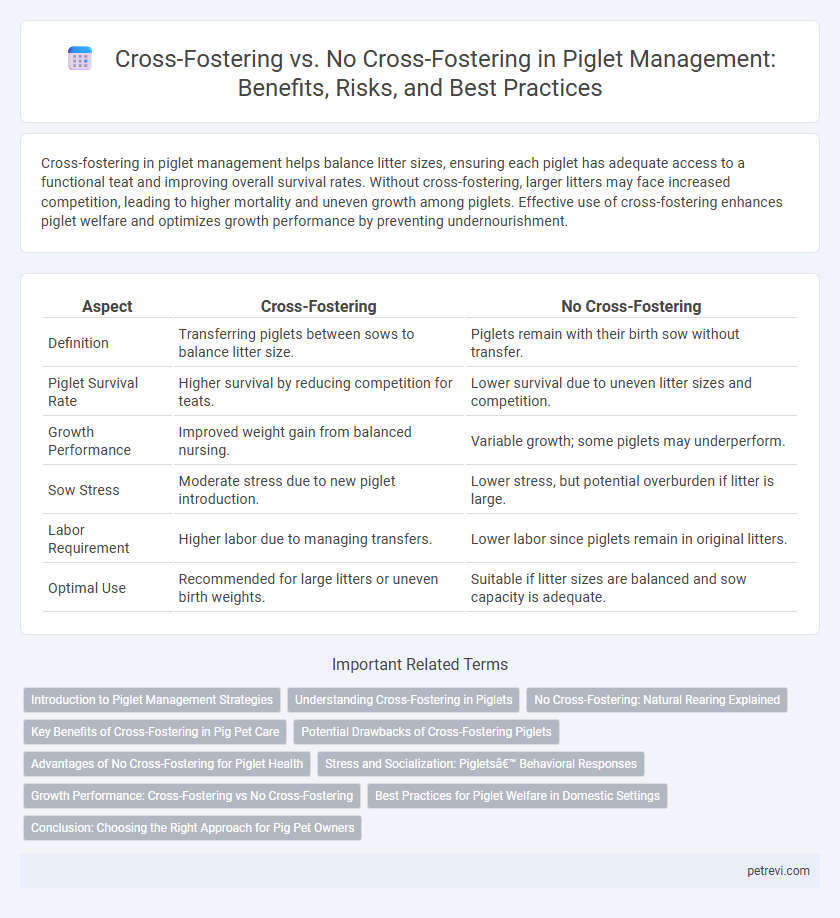Cross-fostering in piglet management helps balance litter sizes, ensuring each piglet has adequate access to a functional teat and improving overall survival rates. Without cross-fostering, larger litters may face increased competition, leading to higher mortality and uneven growth among piglets. Effective use of cross-fostering enhances piglet welfare and optimizes growth performance by preventing undernourishment.
Table of Comparison
| Aspect | Cross-Fostering | No Cross-Fostering |
|---|---|---|
| Definition | Transferring piglets between sows to balance litter size. | Piglets remain with their birth sow without transfer. |
| Piglet Survival Rate | Higher survival by reducing competition for teats. | Lower survival due to uneven litter sizes and competition. |
| Growth Performance | Improved weight gain from balanced nursing. | Variable growth; some piglets may underperform. |
| Sow Stress | Moderate stress due to new piglet introduction. | Lower stress, but potential overburden if litter is large. |
| Labor Requirement | Higher labor due to managing transfers. | Lower labor since piglets remain in original litters. |
| Optimal Use | Recommended for large litters or uneven birth weights. | Suitable if litter sizes are balanced and sow capacity is adequate. |
Introduction to Piglet Management Strategies
Cross-fostering is a piglet management strategy where piglets are transferred among sows shortly after birth to equalize litter sizes and improve piglet survival rates. No cross-fostering relies on natural nursing behaviors, which may result in uneven piglet growth due to competition for teats. Effective piglet management balances fostering techniques to optimize piglet health, growth performance, and sow welfare.
Understanding Cross-Fostering in Piglets
Cross-fostering in piglets involves transferring newborns from large litters to sows with smaller litters to balance nursing demands and improve survival rates. This technique reduces competition for teats, promoting uniform growth and reducing mortality caused by starvation or crushing. Avoiding cross-fostering may lead to uneven piglet development and higher mortality in large litters due to insufficient access to the sow's milk.
No Cross-Fostering: Natural Rearing Explained
No cross-fostering in piglet management allows sows to naturally rear their own litters, promoting stronger maternal bonding and reducing stress for both sow and piglets. This method can enhance piglet immunity through consistent exposure to the sow's microbiota and supports natural suckling behaviors. Studies indicate that avoiding cross-fostering minimizes disruption of piglet social structure, potentially improving overall growth rates and reducing mortality.
Key Benefits of Cross-Fostering in Pig Pet Care
Cross-fostering optimizes piglet survival by balancing litter sizes, ensuring each piglet receives adequate nutrition and maternal attention, which reduces mortality rates and promotes uniform growth. This practice helps manage piglet variability by redistributing piglets from large or less productive sows to those with higher milk production, enhancing overall weaning weights and health status. Cross-fostering also facilitates better colostrum intake, crucial for immunity development, directly improving piglet resilience against diseases in early life stages.
Potential Drawbacks of Cross-Fostering Piglets
Cross-fostering piglets can lead to increased risk of disease transmission due to close contact between litters and disrupt natural sow-piglet bonding, resulting in higher piglet stress and mortality rates. It often causes uneven milk intake as foster sows may reject non-biological offspring or favor certain piglets, compromising growth uniformity. The process also requires additional labor and careful management to prevent injuries and ensure piglet welfare.
Advantages of No Cross-Fostering for Piglet Health
No cross-fostering minimizes stress and reduces the risk of disease transmission among piglets, promoting stronger immune system development. Maintaining the original litter structure supports natural suckling behaviors, enhancing nutrient absorption and overall growth. Avoiding cross-fostering also preserves maternal antibodies and colostrum intake, which are critical for piglet health and survival in the early life stages.
Stress and Socialization: Piglets’ Behavioral Responses
Cross-fostering in piglet management minimizes stress by balancing litter sizes, promoting stable social hierarchies and reducing aggressive behaviors compared to no cross-fostering. Piglets subjected to cross-fostering exhibit faster socialization and improved adaptability, which supports healthier behavioral development. Conversely, no cross-fostering often leads to increased competition and stress, negatively impacting piglet welfare and growth.
Growth Performance: Cross-Fostering vs No Cross-Fostering
Cross-fostering in piglet management significantly enhances growth performance by balancing litter sizes and ensuring uniform access to nipples, which reduces competition and improves weight gain. No cross-fostering often results in uneven sow milk intake and higher mortality rates due to competition among piglets of differing sizes. Studies highlight that cross-fostered piglets achieve higher average daily gain (ADG) and improved weaning weights compared to non-cross-fostered counterparts.
Best Practices for Piglet Welfare in Domestic Settings
Cross-fostering in piglet management enhances survival rates by balancing litter sizes and ensuring uniform access to colostrum, which is crucial for immunity development. Maintaining consistent environmental conditions, such as temperature and hygiene, alongside minimal handling stress, optimizes piglet welfare regardless of cross-fostering practices. Studies indicate that strategic cross-fostering during the first 24 to 48 hours post-birth improves growth performance and reduces mortality without compromising the sow's maternal behavior.
Conclusion: Choosing the Right Approach for Pig Pet Owners
Cross-fostering improves piglet survival rates by balancing litter sizes and ensuring adequate access to sow milk, which enhances growth performance. No cross-fostering reduces stress and disease transmission risks, preserving natural sow-piglet bonding vital for behavioral development. Pig pet owners should evaluate litter uniformity, sow health, and management capacity to select the approach that maximizes piglet welfare and farm productivity.
Cross-fostering vs No cross-fostering for Piglet management Infographic

 petrevi.com
petrevi.com